Getting Up to Speed on Atlantic Yards/Pacific Park
Because my FAQ is way too long, some key articles and concepts.
Atlantic Yards (aka Pacific Park) is super-complicated, given the variety of plans, companies, personalities, and issues—from Barclays Center operations to affordable housing promises—that have surfaced since the project was unveiled in December 2003.
I have a long FAQ on my Atlantic Yards/Pacific Park Report blog, with lots of focused information like chronology, square footage, and shifting images. It contains some useful infographics (some below) and other links/info. The About Me page has a long list of freelance articles.
You can subscribe here to get new coverage and weekly roundups from both this newsletter and my more frequently published Atlantic Yards/Pacific Park Report blog.
Consider this a more focused introduction, focusing on selected articles, most but not all by me. This page will be updated.
The single best distillation is my May 2, 2024 article: Watch This Space, in Urban Omnibus, though it could be far longer. (My working title, “Whatever Happened to Atlantic Yards?”)
In terms of what’s next, a Dec. 10, 2023 article from The Real Deal, Atlantic Yards at 20: Unfinished and facing foreclosure, offered a useful but incomplete summation of factors—including economic and political cycles— hampering the megaproject announced in 2003 by Brooklyn-based Forest City Ratner, with a projected ten-year buildout, and for now overseen by Greenland USA, an arm of a Shanghai-based congolomerate.
Yes, a cascade of problems impeded progress. However, as I wrote Dec. 18, 2023, Was Atlantic Yards Fundamentally Flawed? At the start, Deputy Mayor Dan Doctoroff thought it "a crazy risk" (but didn't say so).\
For some watchwords, see The Mantras of Atlantic Yards, published June 5, 2024, but consolidating previous observations.
What was planned, what was built
Beyond the graphic above, the images below provide a quick portrait of the contrast between what was proposed and built, at least at the arena block, the western third of the project site.
The three renderings in the upper row, all by original architect Frank Gehry, show the arena buried in towers, with the focal point a giant tower, at the corner of Atlantic and Flatbush Avenue, dubbed “Miss Brooklyn.”
(Brooklyn Tomorrow was a promotional publication produced by the New York Post, which at the time owned Community News Group, including two local chains.)
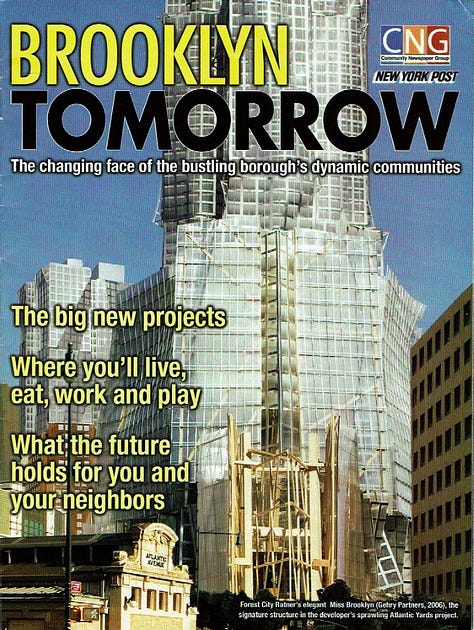
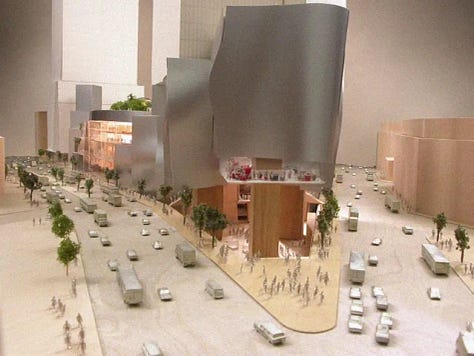

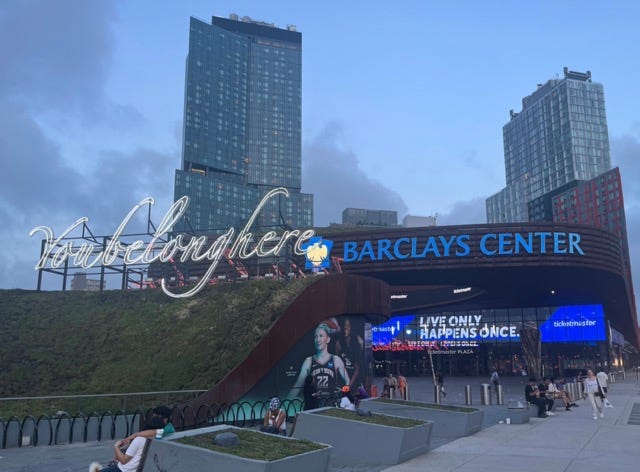
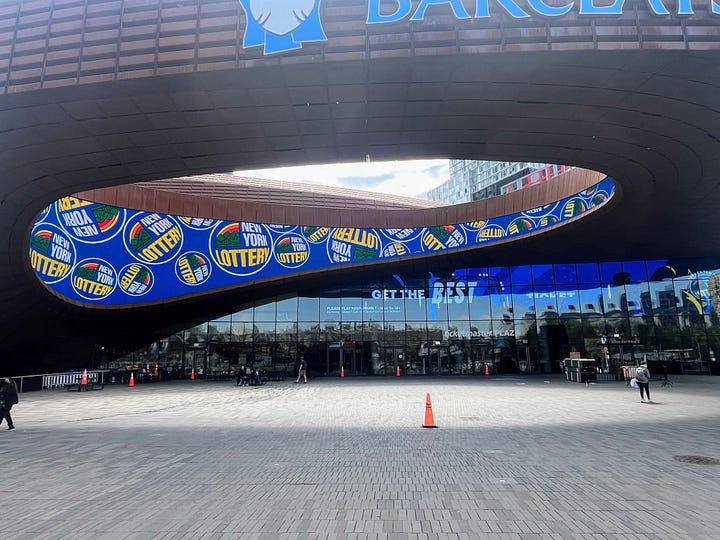
The two photos in the lower row show how Ellerbe Becket arena, revamped by SHoP with a distinctive oculus and a pre-rusted metal “skin,” along with the plaza extending from the arena doors, have redefined the space.
Why the name—and name change?
Atlantic Yards echoed Atlantic Avenue, the northern border of the project site, and the latter name is part of the Atlantic Center and Atlantic Terminal malls across the street, both developed by project sponsor Forest City.
The name “Yards” both reflected projects like Camden Yards in Baltimore and left the impression that the project was limited to an 8.5-acre railyard, not 22 acres. But when Greenland took over in 2014, they changed the name.
Why? As I wrote Aug. 26, 2014 for Next City, After 11 Years of Controversy, Atlantic Yards Becomes Pacific Park Brooklyn, it seemed aimed to game Google, distancing the project not just from past taint controversy but even watchdog journalism.
Since then, the Greenland Forest City Partners joint venture saw Forest City fade away, and new developers have built the most recent towers. On deck, as six tower sites over the railyard are in foreclosure, may be Related Companies.
At the beginning
It’s worth looking back at some of the initial promotion.
As I wrote Dec. 11, 2023: Flashback, Dec. 10, 2003: The Atlantic Yards Unveiling. "Bring Basketball to Brooklyn," urged developer Forest City Ratner's web site. The Nets arrived, but many predictions were puffery.
Dec. 26, 2023: A "Garden of Eden"? Revisiting a NY Times Rave for the 2003 Atlantic Yards Debut. Architecture critic Herbert Muschamp was so dazzled by Frank Gehry's designs he suspended skepticism and got much wrong. But it was quickly cited in a brochure from the developer.
More recently, on June 5, 2024, I revised an ongoing list of The Mantras of Atlantic Yards. Included are “The devil’s in the details,” “It’s a very tight fit,” and much more.
Before project approval
Aug. 4, 2006: Mr. Ratner’s Neighborhood, by Chris Smith, New York magazine. My comments.
Aug. 17, 2006: Open Space in the Atlantic Yards Development, by Anne Schwarts in Gotham Gazette. The numbers are now different but the basic point is clear.
After first project approval in 2006
June 15, 2008: Atlantic Yards: This Generation’s Penn Station?, Places Journal. Answer: it wasn’t.
(There’s a lot missing in this section, I know.)
After project re-approval in 2009
Spring 2010: In The Urban Lawyer, an article co-authored with legal scholar Amy Lavine, Urban Redevelopment Policy, Judicial Deference to Unaccountable Agencies, and Reality in Brooklyn’s Atlantic Yards Project. Excerpts are here. An analysis of the lawsuits, and legal arguments, involving the project.
Nov. 10, 2010: My essay for HuffPost follows up on the legal cases, Judge Slams State Development Agency for "Failure of Transparency."
June 22, 2010: My op-ed in the New York Times Sports section headlined A Russian Billionaire, the Nets and Sweetheart Deals.
March 18, 2011: My Columbia Journalism Review online essay headlined A Sports Myth Grows in Brooklyn. No, the arena is not being built at the same site the Brooklyn Dodgers wanted.
June 3, 2011: My Dissent review of the film Battle for Brooklyn, headlined The Epic Battle Over Atlantic Yards. The film chronicles the battle against Atlantic Yards, though, in hindsight, “for Brooklyn” was overblown.
“If the government had done its job, if the media had done their job, we wouldn’t be here like this,” says an interviewee (me) at the end. “It would’ve been a fair fight.”
Oct. 24, 2011: My essay for City Limits, The Unfulfilled Promises of Atlantic Yards. How is developer Forest City Ratner fulfilling its ambitious promises of jobs, affordable housing, local/minority contracting, and more?
Not so well, though the developer wouldn’t admit it, nor fund the independent monitor that’s supposed to tell us. So much for the Community Benefits Agreement.
Oct. 25, 2011: My essay for Salon, Jay-Z's hip-hop of distraction. The hip-hop superstar hypes a Brooklyn, N.Y., sports arena that failed to deliver on its jobs pledge.
Sept. 10, 2012: My essay, Atlantic Yards, Pacific Park, & the Culture of Cheating, trying to tie things together before the arena opened.
Nov. 6, 2012: My essay for City Journal, The Barclays Center's Media Enabler, on the New York Times's erratic, inadequate coverage. (And more here.) Ironically enough, shrinking publications and budgets, coupled with no institutional memory, mean far less coverage today.
November 2012: My article for The Brooklyn Rail, A Brand Called Brooklyn, on the use of "Brooklyn" to sell the arena and team.
Dec. 14, 2012: My essay for Reuters Opinion, Brooklyn's Vaunted, Tainted Barclays Center. In retrospect, we might have given the arena too much credit, given that it established itself while rival Madison Square Garden was being renovated.
I wrote: “Atlantic Yards ‑ for now, an arena, with one tower slated to start construction on Dec. 18 ‑ should serve as a reminder that, as such complicated deals evolve, the public interest requires constant vigilance.” Still true.
October 2013: An article for The Brooklyn Rail, Barclays Center: Brooklyn’s “Community Arena”? Answer: not really.
Sept. 9, 2013: The Culture of Cheating: What happened to Atlantic Yards/Pacific Park jobs? Far fewer than promised, including construction jobs, office jobs, and arena jobs.
July 10, 2014: The Atlantic Yards Community Benefits Agreement promised a path to union apprenticeships. Instead, BUILD's coveted program provoked a bitter lawsuit, which was settled, ambiguously. Less ambiguous: the false promises of Atlantic Yards jobs.
Sept. 24, 2015: My op-ed in City & State, When Barclays Admitted a Felony, It Should Have Lost the Brooklyn Arena. No one would explain why the bank had not become a “prohibited person.”
Housing emerges
Aug. 26, 2012: An article for City Limits' Brooklyn Bureau, Agency, Developer Wrestle Over Atlantic Yards Affordability. In other words, Forest City wanted to shirk its promises, and city officials made some, limited pushback.
July 3, 2014: An article for City Limits, Behind Atlantic Yards Housing Deal, Some Big Shifts. Yes, there were two new “100% affordable” buildings coming. But they’d mostly serve middle-income households. Similarly, an Aug. 21, 2104 article for BKLYNR, When ‘Affordable’ Rents Push $3,000.
Aug. 31, 2015: An article for City Limits, Documents Reveal Woes at Pioneering Atlantic Yards Building. The first article to uncover the leaks, mold, and other problems at the once-ballyhooed tower known as B2 or 461 Dean Street.
February 22, 2017: An essay for TreeHugger, The World's Tallest Modular Building and the Phantom 20 Percent Savings. The 461 Dean tower lost money, instead.
April 19, 2017: An article for City Limits: The Real Math of An Affordable Housing Lottery: Huge Disconnect Between Need and Allotment. Documents provide what’s intuitively obvious: tens of thousands of low-income applicants vie for relatively few units, while those earning close to six figures have pretty good odds.
Also see my Nov. 16, 2017 essay for City & State/NY: Simplistic Math Mangles the Odds of Affordable Housing Lotteries.
May 14, 2024: What Affordable Housing Graphics Conceal--or Reveal, with graphic designer Ben Keel. See a graphic above produced by New York State, then Keel’s more meaningful presentation below.

EB-5
Three rounds of low-interest investor visa financing, via the EB-5 program, which offers immigrants and their families green cards for putting $500,000 (now more) into a purportedly job-creating investment, have helped fund Atlantic Yards.
After the first round, $228 million via the New York City Regional Center, then came “Atlantic Yards II” ($249 million) and “Atlantic Yards III” ($100 million), with the U.S. Immigration Fund (USIF) as regional center, the intermediary that finds investors and packages the deals—and, thanks to advantageous contractual language has significant control over the investment..
The first fundraising round was paid back, but $286 million of the next two rounds was not paid back, so the USIF has pursued foreclosure, as the six railyard sites (B5-B10) were offered as collateral.

Dec. 8, 2010: Anatomy of a Green Card Pitch: In China, Atlantic Yards Backers Rely on the Distraction of Basketball. Or, at greater length, Dec. 10, 2010: Anatomy of a Shady Deal: an FAQ and retrospective on the effort to recruit EB-5 investors in China for the Brooklyn Arena and Infrastructure Project.
Oct. 16, 2014: In China, Nets' visit boosts "Atlantic Yards III": deceptive pitch for cheap financing from Chinese millionaires seeking green cards under EB-5.
Dec. 15, 2015: a column for the PBS NewsHour: What’s really at stake in the EB-5 investor visa overhaul: honesty.
Jan. 17, 2019: A question from "Atlantic Yards II" EB-5 investors: is construction suspended? Answer: not quite (but no buildings have started for a while).
Uneven progress
July 11, 2016: An article for City Limits, Fuzzy Plans for New Towers at Key Pacific Park Site. That plan, for the parcel known as Site 5 catercorner to the arena, is still fuzzy, but likely to re-emerge in 2024.
March 20, 2018: An article for The Bridge: Forest City in Brooklyn: a Real Estate Pioneer on the Way Out? The developer behind MetroTech and Barclays Center changed the borough's landscape, not without controversy.
Sept. 24, 2018: Brookfield agreement to acquire Forest City Realty Trust backed after hedge funds finessed new board, contentious debate over value, and narrow 7-5 vote. It’s all about short term profit, which is why shareholders, as I reported Nov. 16, 2018, approved the deal.
Aug. 20, 2018: An article for The Bridge: Developer Admits Pacific Park Project Will Take Until 2035. That was confirming what was generally known. Affordable housing was still due by May 2025.
Nov. 15, 2018: An essay for the Brooklyn Eagle: For Amazon HQ2 deal, Atlantic Yards serves as a warning.
Arena focus
Dec. 10, 2019: An essay for City & State, Brooklyn’s Barclays Center is a questionable part of Bloomberg’s legacy. The mayor showed solicitousness toward fellow moguls above all.
June 10, 2020: An essay for Bklyner, Brooklyn's Accidental New Town Square, about how protests after George Floyd’s murder gathered at the arena plaza, eased by the Barclays Center’s shuttered status.
Dec. 6, 2021: An essay for The Indypendent: Art or Advertising? The Contradictions of the "You/We Belong Here" Signage at Barclays Center.
Aug. 29, 2023: An essay for Common Edge: Revisiting Brooklyn’s Barclays Center—a Telling Landscape. There’s a lot more advertising than at the start.
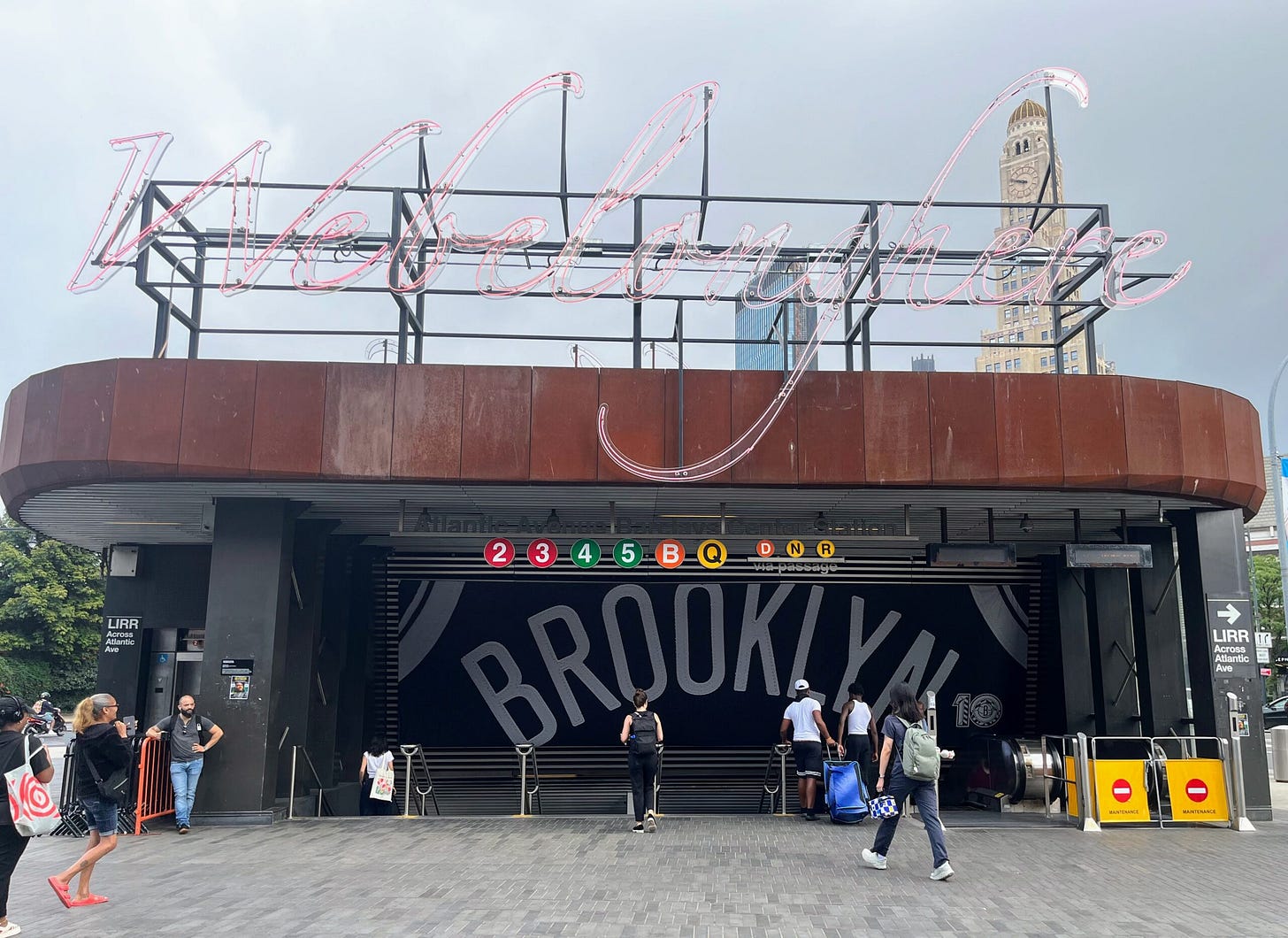
What’s next?
Aug. 24, 2023: An article for City Limits: State Weighs Tax Deal, Plans ‘Public Engagement’ for Atlantic Yards as Housing Deadline Nears. That didn’t happen, but something Related might recur.
Jan. 2, 2024: It's the Oversight, Right? New York State has let the developer off the hook. Why no legislative hearings?
Jan. 8, 2024: Does Atlantic Yards Need a Plan? Or a Process? Two advocates from the BrooklynSpeaks coalition, an a New York Daily News essay, propose a new LDC and federal help for affordable housing. Maybe caution is in order.
Jan. 16, 2024: New Renderings (& Animation): Towers Along Atlantic Avenue. As approved, six large towers, containing nearly 3.5 million square feet, would change the streetscape.
In other words, no one is thinking yet about what the project might look like if actually finished.
June 25, 2024: An essay for Common Edge: As Brooklyn Nets’ Value Booms, a Missed Opportunity With the Arena, followed up by July 16, 2024, Would Joe Tsai's Slickest Move Be Poaching Ticketmaster Plaza?


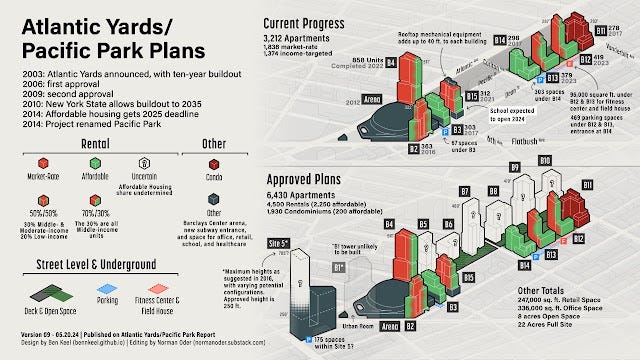
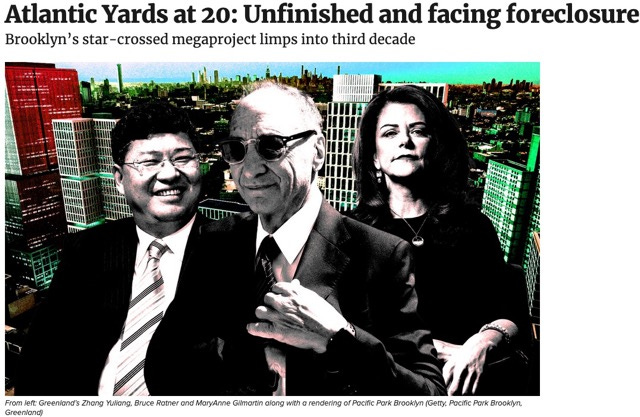
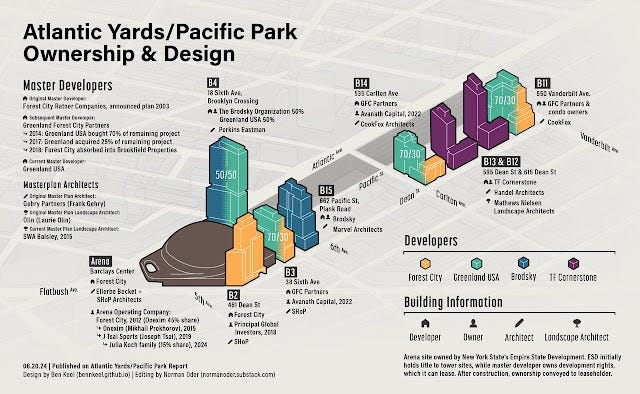
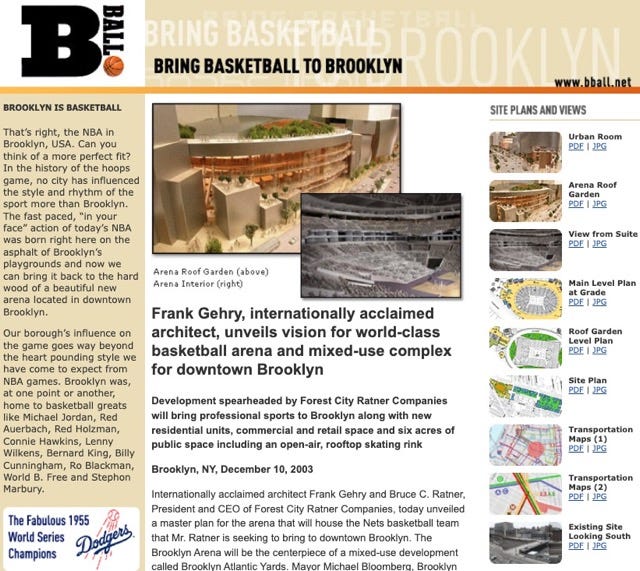


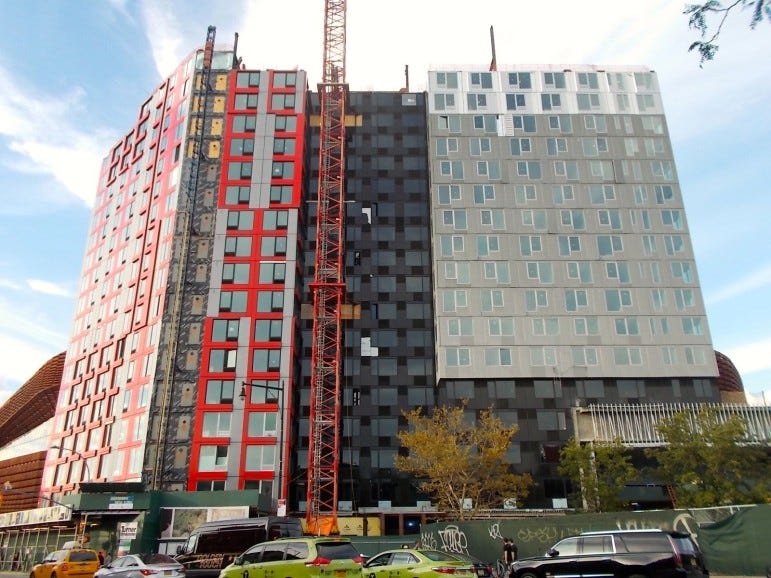
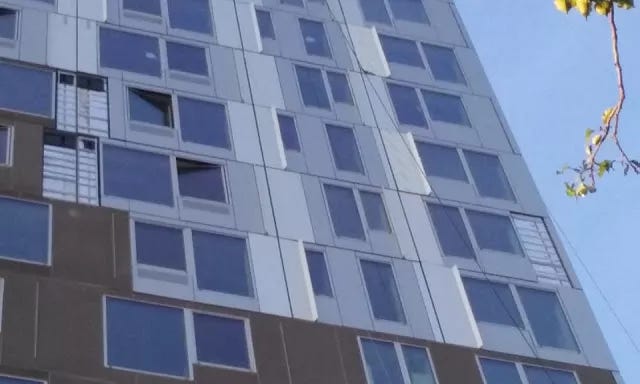
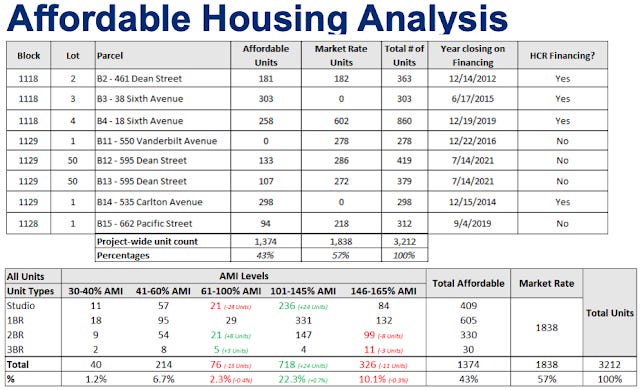


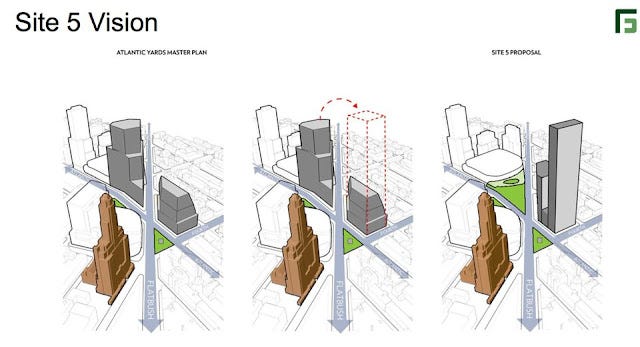
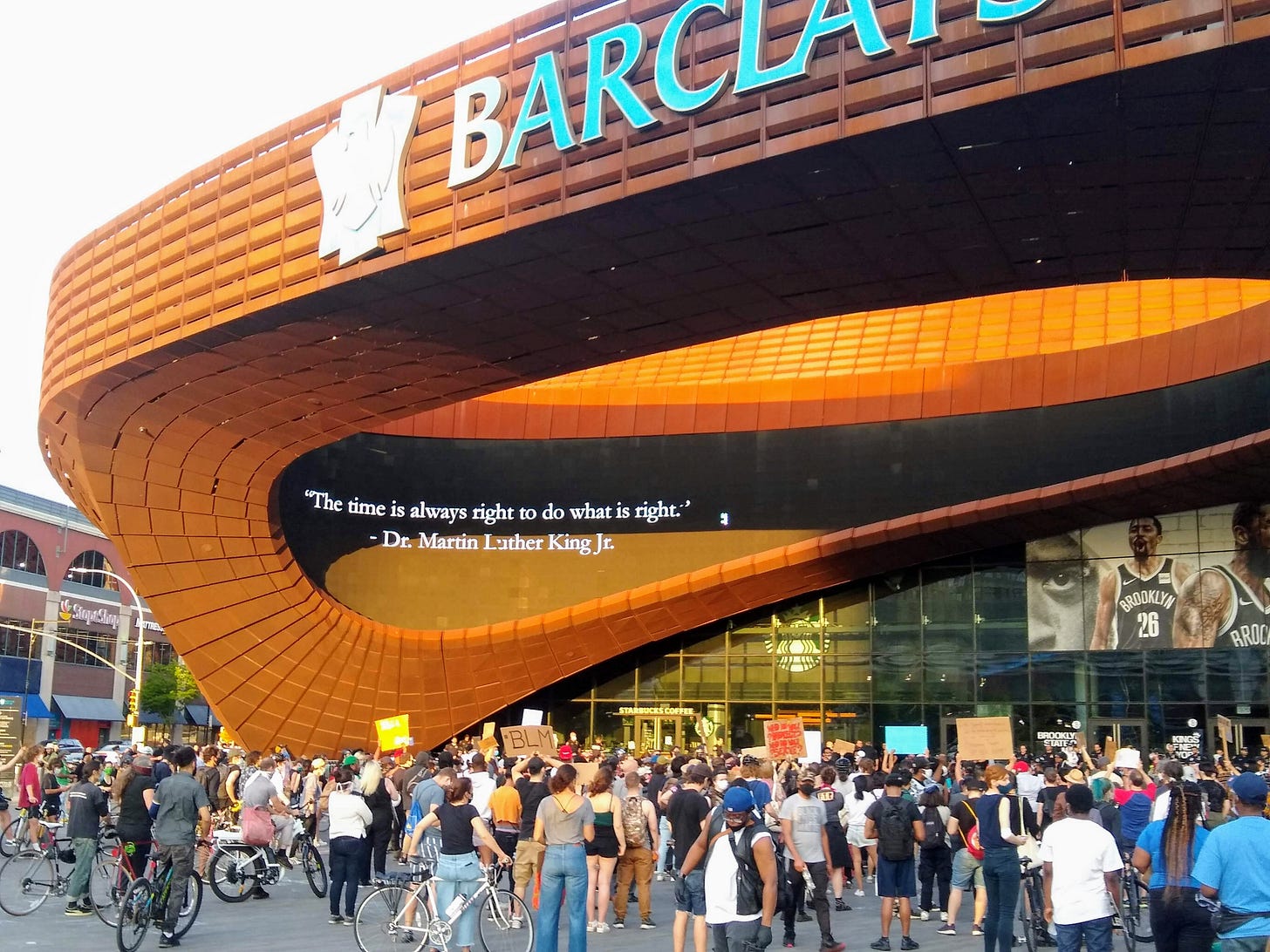

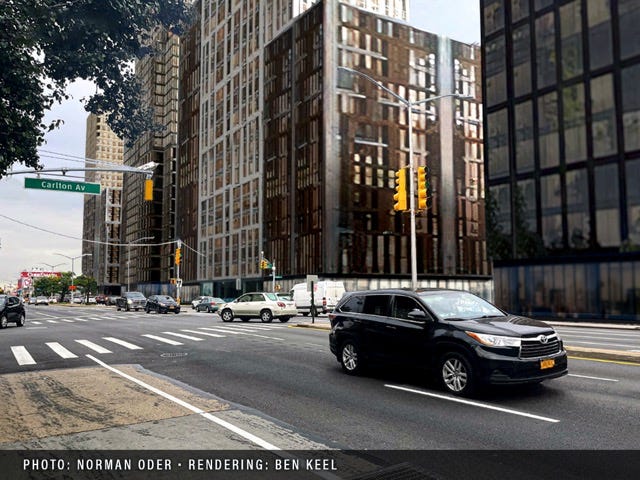
How would you compare this project with the hudson yards project? Also, how would this project with the development in Williamsburg over the past 20 years?